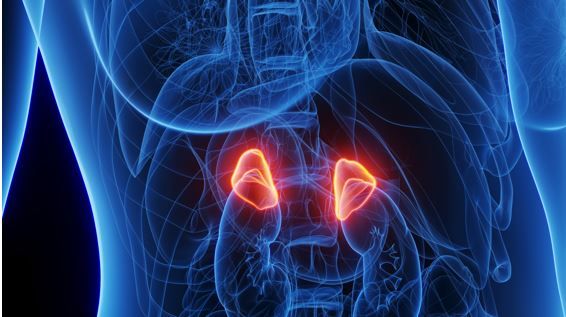- Clinical Technology
- Adult Immunization
- Hepatology
- Pediatric Immunization
- Screening
- Psychiatry
- Allergy
- Women's Health
- Cardiology
- Pediatrics
- Dermatology
- Endocrinology
- Pain Management
- Gastroenterology
- Infectious Disease
- Obesity Medicine
- Rheumatology
- Nephrology
- Neurology
- Pulmonology
Neurocrine Biosciences CAHtalyst Adult Phase 3 Clinical Trial Meets All Endpoints in Congenital Adrenal Hyperplasia, Published in NEJM
The registrational clinical trial met all endpoints related to androgen reduction and glucocorticoid dose reduction while maintaining androgen control.
Neurocrine Biosciences announced that the primary findings from the company’s pivotal CAHtalyst Adult Phase 3 study of crinecerfont have been published online in the New England Journal of Medicine. The CAHtalyst study is investigating crinecerfont for the treatment of adults ages 18 and older with congenital adrenal hyperplasia (CAH) due to 21-hydroxylase deficiency.
©Sebastian Kaulitzki/stock.adobe.com

The study met its primary and key secondary endpoints with crinecerfont treatment decreasing levels of androstenedione and permitting reduction of glucocorticoid dose while also maintaining androstenedione control, according to the Neurocrine announcement. Specifically, 62.7% of participants treated with crinecerfont achieved a physiologic glucocorticoid dose while maintaining androstenedione control compared with 17.5% of those treated with placebo. Investigators also reported promising trends in endpoints reflecting consequences of long-term supraphysiologic glucocorticoid therapy.
"Since the 1950s, glucocorticoids have been required not only for cortisol replacement, but also to control the excessive amount of adrenal androgens in patients with congenital adrenal hyperplasia. As a result, CAH patients suffer from a higher prevalence of disorders attributable to supraphysiologic GC levels, including osteoporosis, obesity, insulin resistance, diabetes mellitus, hyperlipidemia and hypertension," principal investigator Richard Auchus, MD, PhD, professor of pharmacology and internal medicine, division of metabolism, endocrine, and diabetes at the University of Michigan, said in the press release.
"The CAHtalyst Adult Phase 3 study demonstrated that crinecerfont achieved a significantly greater GC reduction from week 4 through week 24 than placebo while androstenedione was maintained and did so safely. Crinecerfont could be the treatment alternative that we've needed to effectively treat our CAH patients while mitigating the comorbidities found with the existing treatment paradigm."
Crinecerfont is an investigational, oral, selective corticotropin-releasing factor type 1 receptor (CRF1) antagonist being developed to reduce and control excess adrenocorticotropic hormone (ACTH) and adrenal androgens through a glucocorticoid-independent mechanism for the treatment of CAH due to 21-hydroxylase deficiency.
CAHtalyst Adult Phase 3 was a global registration study and enrolled 182 participants of which more than 95% completed the 24-week double-blind, placebo-controlled treatment period with nearly complete data. Neurocrine reported findings for the primary and key secondary endpoints as follows:
Primary endpoint findings
- Crinecerfont treatment led to a significantly greater GC dose reduction at week 24 while maintaining androstenedione control compared to placebo (least squares mean [LSM] percent change from baseline of -27.3% versus -10.3%, with LS mean difference [LSMD] of -17.0%, P < .001).
- This corresponded to changes of -4.8 and -2.1 mg/m2 /day hydrocortisone equivalents for crinecerfont and placebo, respectively
- After the initial 4-week GC stable period, mean percent GC reduction (while androstenedione was controlled) was greater with crinecerfont than placebo at all timepoints, an effect maintained from weeks 12 to 24, while GC levels increased from weeks 12 to 24 for participants on placebo.
Key secondary endpoint findings
- Crinecerfont treatment led to a significantly greater reduction in androstenedione compared to an increase with placebo at Week 4 (LS mean change from baseline of -299 ng/dL versus +45.5 ng/dL, with LSMD of -345 ng/dL; P <.001).
- The significant reduction in androstenedione levels while GC was stable provides clear evidence of the ability of crinecerfont to reduce elevated adrenal androgen levels through a non-GC mechanism.
Auchus and colleagues also reported favorable trends for endpoints associated with long-term use of GC, including body weight, insulin resistance and glucose tolerance despite the short period of reduced GC dose. They also saw relief from GC-induced suppression of bone turnover in the form of an increase in bone resorption and formation markers.
Crinecerfont had a favorable tolerability profile with few study discontinuations related to adverse events (AEs). The most common AEs reported were fatigue and headache, according to the study. There were very few serious AEs and none were assessed as related to the study drug. No safety concerns arose related to adrenal crisis and the incidence of AEs that led to glucocorticoid stress dosing were similar in the crinecerfont and placebo groups.
The findings from the study represent a “potential paradigm shift in treatment for adult patients living with this disorder over many years, who consistently struggle with the clinical consequences of poor androgen control and/or excess glucocorticoid caused by current inadequate treatment approaches," Eiry W Roberts, MD, chief medical officer, Neurocrine Biosciences concluded.
References
Neurocrine Biosciences announces publication of primary CAHtalyst Adult phase 3 study Results of crinecerfont for the treatment of CAH in the New England Journal of Medicine. News release. Neurocrine Biosciences. June 3, 2024. Accessed June 5, 2024. https://neurocrine.gcs-web.com/news-releases/news-release-details/neurocrine-biosciences-announces-publication-primary-cahtalysttm
Auchus RJ, Hamidi O, Pivonello R, et al for the CAHtalyst Adult Trial Phase 3 trial of crinecerfont i adult congenital hyperplasia. N Engl J Med. Published online June 1, 2024. doi: 10.1056/NEJMoa2404656
Atopic Dermatitis: The Pipeline and Clinical Approaches That Could Transform the Standard of Care
September 24th 2025Patient Care tapped the rich trove of research and expert perspectives from the Revolutionizing Atopic Dermatitis 2025 conference to create a snapshot of the AD care of the future.
